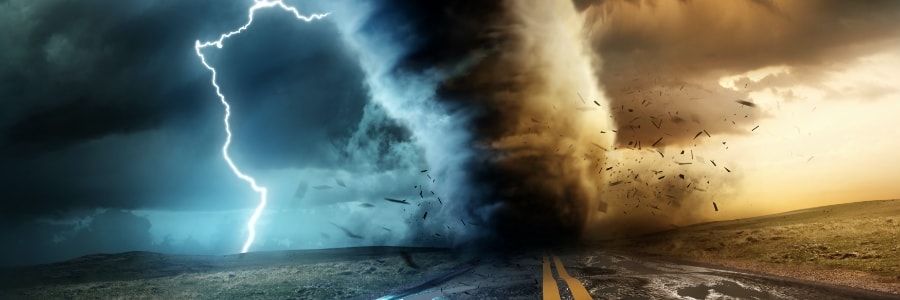

When you think of a disaster that can bring your construction business to a halt, you probably think of hurricanes, tornadoes and other major natural disasters. The truth is, even something as simple as a broken pipe can prevent your construction firm from completing projects on time and under budget. With careful planning, however, you can ensure business continuity after almost any type of disaster.
1. Develop a Disaster Recovery Plan
The key to successful disaster recovery is developing a disaster recovery plan before you ever need one. Depending on the size of your construction firm, your disaster recovery plan may include recovery strategies for hardware, software applications, server rooms and wireless technology.
Items To Include in a Disaster Recovery Plan
Every disaster recovery plan should include several key items. One of the first things to think about is what your recovery point objective and recovery time objective should be. Your RPO is the maximum amount of data your business can afford to lose. Some businesses can afford to lose up to a day's worth of data, while others would be crippled by the loss of even an hour's worth. RTO is the maximum amount of time your business can tolerate it taking to recover normal operations. One construction firm might be able to tolerate a 12-hour recovery window, while another firm might have a much lower RTO.
Inventory Lists
Next time you have a planning meeting, ask team members to come up with a list of hardware and software assets your business needs to operate. Once you have an initial list, classify each item as critical, important or unimportant. An "unimportant" item is something you might use once a week or once a month, while an important item is something you use every day — like bookkeeping software used to record project expenses. If a disaster occurs, you'll be able to consult this list and replace the most critical items first, preventing further disruptions to your business.
Storage Media and Copies of Documents
If a disaster takes your construction business offline, it's much easier to start operating again if you have external hard drives, DVDs and other storage media containing copies of critical files. Your company can also benefit from having copies of important documents, such as business licenses, available in the event of a disaster.
Site Listing
When a disaster occurs, your response team needs to know exactly where they can find company assets. That's why your recovery plan should include a list of sites where you're keeping customer data, financial data and other information you need to get your business up and running quickly. The list should also identify sensitive data that's subject to privacy regulations, as team members need to take extra steps to protect this data against unauthorized access or distribution.
2. Have a Business Continuity Plan in Place
You also need to have a plan for business continuity, which is different from a disaster recovery plan. The continuity planning process involves coming up with ways to continue your business operations in the event of a short-term outage or long-term outage. Your business continuity plan should include all critical business functions, not just the ones associated with your IT assets.
Once you have a plan in place, you need to test it regularly. The simplest way to test this type of plan is to meet with your team and have everyone look for potential gaps. During the meeting, team members should also check the plan to make sure it includes every department of the company, from your accounting team to your laborers. You can also test your plan by doing drills or having team members role-play what they’d do if a disaster occurred. This can help you identify critical gaps in the plan and address them before a real disaster occurs.
3. Hire an IT Firm To Help With Disaster Recovery Planning
When disaster strikes, it's important to have experienced professionals on your side. If you already have an established relationship with an IT services firm, it's much easier to develop a recovery plan and continue operating even after a major natural disaster. If you don't have an established relationship, here's what to look for when assessing a potential IT partner:
- How long have they been in business?
- What pricing structure do they use?
- Can the company help you with hardware, software and cloud-based applications?
- Do you need to pay for ongoing managed services?
- Do they have experience working with companies in the construction industry?
- Does the company have a good reputation?
4. Plan the Recovery Process Ahead of Time
Your organization's disaster recovery plan should designate several employees to serve on a disaster recovery team. Team members should have good working knowledge of your business processes and understand the importance of disaster planning for construction firms. Make sure you designate at least one person to handle each of the following tasks:
- Declaring a disaster and setting the recovery plan in motion
- Performing regular data backups
- Planning for business continuity
- Managing the crisis and helping the firm recover as quickly as possible
- Speaking with members of the press about the crisis
- Communicating with customers regarding their projects
- Working with vendors to replace affected hardware and software
5. Perform Regular Data Backups
A natural disaster can wipe out your hard drives and servers, so make sure you back up important data regularly. This is a critical component of data management for construction firms of any size.
Get Help Preparing for a Disaster
Is your business prepared for a natural disaster? If not, Haycor Computer Solutions can help your construction firm conduct a business impact analysis, develop a disaster recovery plan and continue operations if a disaster occurs. Contact us at (905) 707-6775 to learn more.






